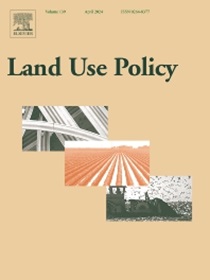(Non-)terrestrial and (Non-)local pathways of behavioral policy diffusion in European cities’ climate action plans: Contextual, cultural, and leadership framing
IF 6
1区 社会学
Q1 ENVIRONMENTAL STUDIES
引用次数: 0
Abstract
This study investigates the spread of innovative behavioral (green nudging) policies within city-level Climate Action Plans (CAPs) across the European Union, focusing on how these innovations diffuse and the factors influencing their adoption. Using textual analysis with a dataset consisting of CAPs from 40 cities across Europe, we categorized various green nudging innovations and then tracked their origins and uptake. Then, we employed fsQCA (Fuzzy set qualitative comparative analysis) to identify the key factors driving diffusion. The findings reveal that while certain innovations, particularly in the building and transportation sectors, have achieved widespread adoption, other initiatives like community co-creation and urban parks have seen lower diffusion. Local terrestrial factors, especially sectoral carbon emissions, are significant drivers, with cities facing higher emissions more likely to adopt these policies. Interestingly, local emissions levels and strong climate leadership emerge as more critical determinants than economic status or climate similarities. The study identifies two primary diffusion pathways—Cultural Leadership for Emission Reduction and Local Adaptive Synergy—demonstrating the diverse strategies cities employ based on their unique contexts. This research highlights the importance of expanding green nudging measures in CAPs beyond technological and infrastructure domains to promote low-carbon behaviors comprehensively.
(欧洲城市气候行动计划中行为政策传播的(非)陆地和(非)地方途径:背景、文化和领导力框架
本研究调查了创新行为(绿色引导)政策在欧盟城市一级气候行动计划(CAPs)中的传播情况,重点关注这些创新如何传播以及影响其采用的因素。通过对欧洲 40 个城市的 CAP 数据集进行文本分析,我们对各种绿色引导创新进行了分类,然后追踪了它们的起源和采用情况。然后,我们采用模糊集定性比较分析(fsQCA)来确定推动传播的关键因素。研究结果表明,虽然某些创新,尤其是建筑和交通领域的创新,已经得到了广泛采用,但社区共建和城市公园等其他举措的推广程度较低。当地的陆地因素,尤其是部门碳排放量,是重要的推动因素,排放量较高的城市更有可能采用这些政策。有趣的是,与经济状况或气候相似性相比,当地排放水平和强有力的气候领导力成为更关键的决定因素。研究确定了两种主要的推广途径--减排文化领导力和地方适应性协同作用--表明了城市根据其独特的环境所采用的不同策略。这项研究强调了将联合行动方案中的绿色引导措施扩展到技术和基础设施领域之外,以全面促进低碳行为的重要性。
本文章由计算机程序翻译,如有差异,请以英文原文为准。
求助全文
约1分钟内获得全文
求助全文
来源期刊

Land Use Policy
ENVIRONMENTAL STUDIES-
CiteScore
13.70
自引率
8.50%
发文量
553
期刊介绍:
Land Use Policy is an international and interdisciplinary journal concerned with the social, economic, political, legal, physical and planning aspects of urban and rural land use.
Land Use Policy examines issues in geography, agriculture, forestry, irrigation, environmental conservation, housing, urban development and transport in both developed and developing countries through major refereed articles and shorter viewpoint pieces.
 求助内容:
求助内容: 应助结果提醒方式:
应助结果提醒方式:


